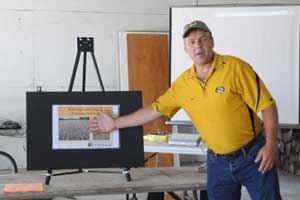MU Researchers Explore Inter-Seeding Cover Crops
COLUMBIA, MO.
Planting cover crops is a time-sensitive activity. That’s why agriculture specialists with University of Missouri Extension are researching inter-seeding cover crops into corn and soybean fields.
“A lot of times waiting until after harvest is not the optimum seeding window for the cover crop,” says Charlie Ellis, MU Extension natural resources engineer.

University of Missouri Extension natural resources engineer
Charlie
Ellis describes research on inter-seeding
cover crops to a group of
farmers at a field day.
That’s why different delivery methods are being explored like airplanes or high-clearance seeders to drop cover crop seeds, such as cereal rye grass or crimson clover, into the existing crop canopy at the optimum time.
If it’s successful, Ellis says the upside is that the labor is done during a time farmers aren’t as busy. The downside is whether rainfall and growing conditions are right for the new crop to start.
“If we wait until after the corn or soybeans are (harvested) and do the seeding then we are going to have a better chance of getting some establishment,” Ellis says. “But by that time our cover crop choices are limited to only species suited for late September or October.”
Ellis says inter-seeding shouldn’t cause a yield loss because existing crops are mature, although some soybeans planted in 15-inch rows may be knocked down. He says 30-inch beans can be inter-seeded without much crop damage.
“For corn, knocking some tassels out does not inhibit yield at that time,” he says. “So we’re pretty confident that we can get cover crops seeded in corn without a yield loss.”
Ellis also notes there are some other novel approaches to cover crop seeding such as tweaking planters to plant cover crops or dropping cover crop seeds from combines during harvest.
“And a lot of farmers are working at on-farm inventions to find alternative methods of inter-seeding cover crops,” Ellis says. ∆